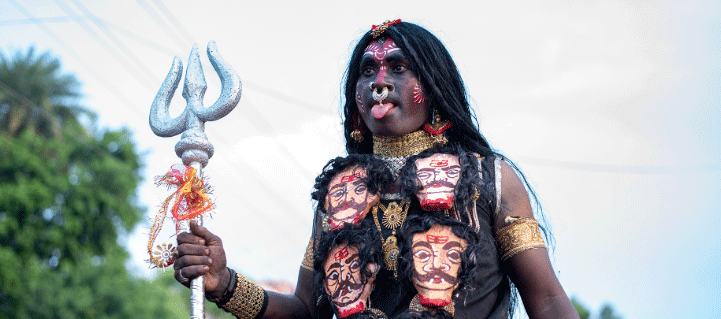Bhawanipatna: The quiet town in the Kalahandi district witnesses one of Western Odisha’s largest and most unique religious spectacles: the centuries-old Maa Manikeswari Chhatar Yatra. This festival on Maha Ashtami is a remarkable confluence of tribal and non-tribal traditions, devoted to Maa Manikeswari, the presiding deity of the Kalahandi region.
The Chhatar Yatra begins in the late hours of Maha Ashtami, or the early dawn of Maha Navami, after a highly secret ritual known as the Munda Basa (replacement of the deity’s head) and Gupta Bali (secret sacrifice) at a place called Jenakhal, approximately three kilometres from the main temple.
The procession centers around the Vijay Chhatar (Victory Umbrella), a sacred bamboo structure veiled in black and gold cloth, symbolizing the presence of Maa Manikeswari. A silver plate bearing the Dasamahavidya Yantra is installed on top, representing the goddess’s ten Tantric forms.
The ‘Chhatar’ is carried in a grand procession back to the main palace temple. This return journey is a momentous occasion, accompanied by the enthralling beats of traditional instruments like the Jena Badya and the powerful Ghumura Badya, a folk dance and music heritage of Kalahandi.
The procession is a vibrant tableau featuring groups of devotees and folk artists, some dressed as traditional Kandha tribal warriors and mythological figures, adding a raw, visceral energy to the religious event. The sound and sight of this massive congregation create an electrically charged, palpable wave of faith.
The Chhatar Yatra is a profound expression of the devotees’ deep faith, where the roads of Bhawanipatna are completely covered by a sea of people.
Along the yatra route, devotees offer prayers, flowers, coconuts, and incense. In a deeply rooted, age-old custom, many worshippers follow the procession and perform animal sacrifices (goats and fowl) as a traditional mark of fulfilling their vows and seeking the goddess’s supreme blessings. This practice, though often debated, is performed with deep religious conviction and an understanding of the ancient Shaktism tradition prevalent in Eastern India.
It is a deeply held belief that witnessing the Chhatar Yatra and seeking blessings from the deity on this day brings prosperity, protection from evil, and the fulfillment of all wishes, drawing lakhs of devotees even from neighboring states like Chhattisgarh and Andhra Pradesh.
Maha Ashtami in Odisha, therefore, is not merely a ritual observance, but a spectacular, faith-filled testament to the enduring power and manifold grace of the Mother Goddess, uniting diverse communities in a single, magnificent devotional celebration.


